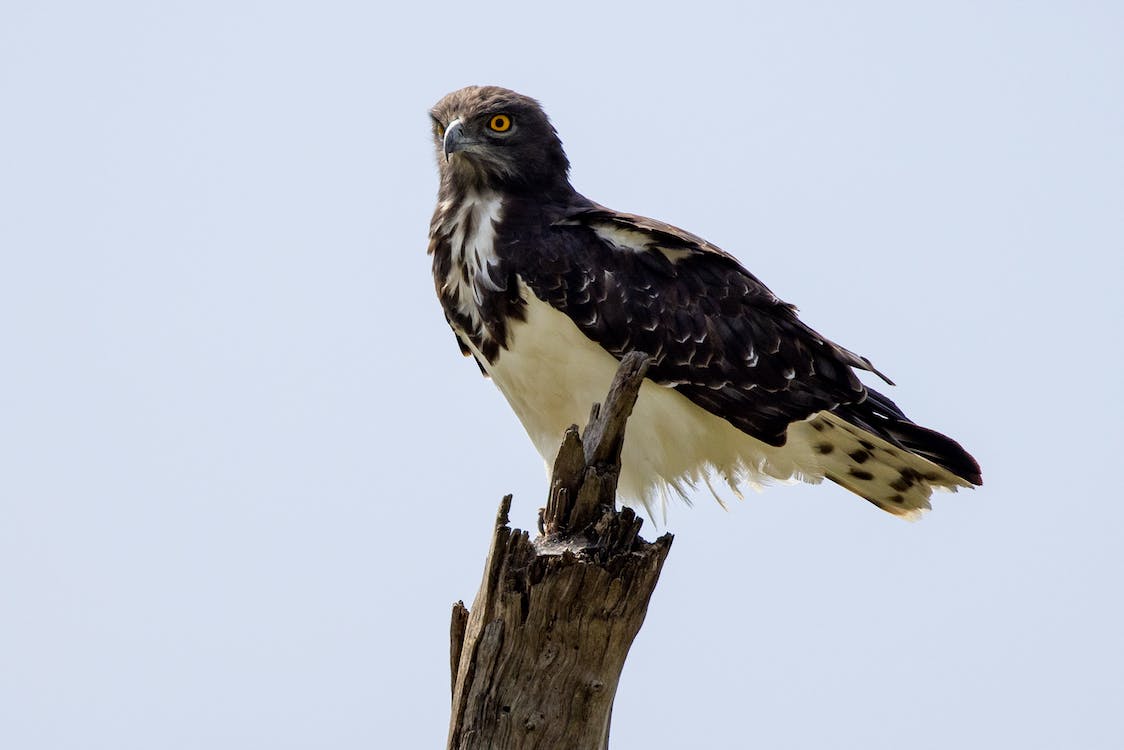It is the largest and strongest African eagle, sporting a short crest. Either singly or in pairs, it thrives in plains, semi-deserts, and open lands, hunting for vertebrates using their incredibly keen eyesight that allows them to detect prey a few kilometers away. This has a unique hunting technique compared to its eagle cousins, soaring high then diving quickly to surprise its prey from above.
Read further to know more about the Martial Eagle.
What is a Martial Eagle?
Martial Eagle is a massive eagle native and spread throughout much of sub-Saharan African. It is the only species from the Polemaetus genus, whose tarsi is covered with feathers. It is a relatively opportunistic predator with a varied diet selection, ranging from birds, mammals to reptiles. These birds are one of the most persecuted bird species globally, due to their behavior of preying on livestock and for being a valuable game bird.
Its seven levels of classification are as follows:
Kingdom: Animalia
Phylum: Chordata
Class: Aves
Order: Accipitriformes
Family: Accipitridae
Genus: Polemaetus
Species: P. bellicosus
Martial Eagle Physical Description
Martial Eagles are the largest eagle of all the African eagle species, growing from 78 to 96 centimeters or 31 to 38 inches, weighing up to 2.2 to 6.5 kilograms, with a wingspan to 6 feet 2 inches to 7 feet and 5 inches. This bird boasts immense power and is believed to have enough strength to knock an adult individual off his feet or break his arm.
Adult plumage shows dark brown upperparts, while the head and the upper chest have subtler edgings. Dark feathers can differ due to light conditions, appearing grayish, darkish, or even plum-colored. Meanwhile, underparts are white, accentuated by a few dark-brownish bars. A short erectile crest occurs on the head but doesn’t appear prominent compared to the crowned eagle, seemingly laying flat.
Juveniles or immature appear quite different from adults. Their plumage is grayish above with ample white edges and a barred-grayish effect on the hind neck and crown. Underparts are white while wing tetrices are speckled with white and grayish-brown hue. Bars patterns occur on the primary feathers, while eyes tend to have a dark brown tone.
Where can they be spotted?
Martial Eagles thrive in plains, semi-deserts, openlands, savannas, and thornbush areas while avoiding extremely arid desert and closed-canopy forests. They occur in much of sub-Saharan Africa, starting from Senegal to Somalia, going downwards to the Cape.
Interesting Facts You Should Know About the Martial Eagle
Martial Eagles are opportunistic predators whose diet revolves around mammals, reptiles, and birds. They are extremely powerful, and they can hunt monkeys, hyrax, antelopes, young lambs and goats, and water birds such as geese, herons, and storks. Occasionally, they may pursue more dangerous prey, such as mongoose, snakes, jackals, serval cats, and monitor lizards.
These birds are equipped with incredibly keen eyesight and can spot prey up to six kilometers away. They do most of their hunting while soaring, using a unique technique characterized by a long slanting descent in open areas that surprises their prey or a gentle stoop in more enclosed locations but with a steeper angle.
Outside the breeding season, pairs are often seen in trees up to several miles from their nesting sites, hunting for several days in one area before transferring to another depending on the availability of food.
These birds are monogamous and will form lifelong bonds with their partners. Unlike other birds, they do not perform striking flight displays. Instead, they conduct mutual circling, in which the pair circles and calls over their territory or range, with the female, sometimes turning or presenting its talons.
The breeding season varies greatly depending on the range, but usually takes place from April to November. Both sexes construct the nest and place in the main fork of large trees around 20 to 66 feet above the ground. The female lays one egg, rarely two, every other year, which she will solely incubate for about 45 to 53 days.
After hatching, the brood is usually feeble and weak, and will only become active after 20 days. The chick will be able to feed on its own at around 63 to 77 days old and will soon fledge at approximately 109 days. However, it will still remain under parental care for another 6 to 12 months before reaching sexual maturity at 4 to 5 years old.
Martial Eagles’ population size is decreasing to habitat loss and powerline collisions. They are also persecuted by farmers as they often hunt domestic animals. These birds are either shot or poisoned, as they are deemed to be a threat to livestock. Moreover, these eagles have a low reproductive rate, giving birth to usually one chick every year two years, which poses another issue to its long-term survival. Martial Eagles are currently classified as Vulnerable (VU) under the IUCN Red List of Threatened Species.
WILDLIFE PARKS AND RESERVES WHERE THIS SPECIES IS FOUND:
BOTSWANA
SOUTH AFRICA
Kalahari Gemsbok National Park
NAMIBIA
ZAMBIA
ZIMBABWE
BOTSWANA BIRDS | SOUTH AFRICA BIRDS
NAMIBIA BIRDS | ZAMBIA BIRDS | ZIMBABWE BIRDS

